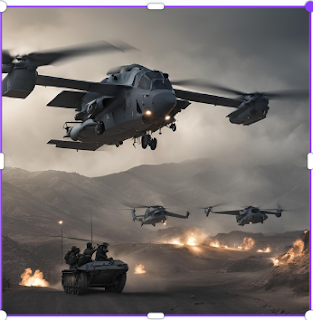The Role of Artificial Intelligence in Modern Warfare
 |
Introduction
The use of artificial intelligence (AI) in modern warfare has become a critical factor in shaping military strategies and operations. From intelligence gathering to autonomous weapons, AI-driven technologies have revolutionized the battlefield, influencing both the conduct and outcomes of wars. Recent conflicts, such as the Russian-Ukrainian war and the ongoing war in Gaza, have demonstrated the increasing reliance on AI in military decision-making. However, this technological advancement raises concerns about ethical implications, security risks, and the potential to prolong conflicts. This article explores the role of AI in modern warfare, its benefits, risks, and future implications.
Increasing Uses of AI in Warfare
AI has various applications in military operations, enhancing efficiency, precision, and strategic decision-making. Some of the key areas where AI is making an impact include:
1. Enhancing Intelligence and Information Processing
AI strengthens intelligence gathering and strategic analysis by processing vast amounts of data to detect military patterns and trends.
AI-powered reconnaissance and surveillance systems utilize satellite imagery, drones, and sensors to collect real-time battlefield data.
Advanced encryption and cybersecurity measures leverage AI to protect military communications and sensitive information from cyber threats.
2. Monitoring Public Opinion and Media Influence
AI analyzes social media platforms, news outlets, and online forums to assess public sentiment regarding conflicts.
Machine learning algorithms help governments and military organizations understand how warfare impacts public perception and policy decisions.
3. Risk Assessment and Military Decision-Making
AI systems evaluate potential threats, predict enemy movements, and provide real-time risk assessments to commanders.
Machine learning models simulate battle scenarios, allowing military planners to strategize more effectively.
4. AI in Combat and Autonomous Weapons
AI-powered drones and autonomous weaponry improve target precision, reducing human errors and collateral damage.
AI assists in identifying enemy combatants, classifying threats, and coordinating military units on the battlefield.
The development of lethal autonomous weapons systems (LAWS), also known as "killer robots," raises concerns over accountability and ethical warfare.
5. Post-War Reconstruction and Humanitarian Aid
AI-driven image and video analysis aid in damage assessment and prioritization of rebuilding efforts in war-torn regions.
AI enhances humanitarian response by analyzing data on displaced populations, facilitating aid distribution, and supporting reconciliation initiatives.
Real-World Examples of AI in Warfare
Ukraine leverages AI-driven software like Palantir to analyze satellite imagery, open-source intelligence, and battlefield data.
AI supports war crime investigations by analyzing digital evidence from drones and surveillance footage.
Russia has reportedly deployed AI-guided munitions such as the ZALA Aero KUB-BLA drone, while Ukraine employs autonomous capabilities in Bayraktar TB2 drones.
The Gaza Conflict
Israel reportedly uses AI tools like "Lavender" to identify high-value targets, allegedly marking thousands of individuals for strikes.
AI-driven surveillance and tracking systems monitor enemy movements and infrastructure.
However, concerns over civilian casualties and ethical implications have been raised due to AI’s role in targeting operations.
Risks and Ethical Concerns
Despite AI’s advantages in warfare, its implementation comes with significant risks:
1. Civilian Casualties and Collateral Damage
AI-driven weapons may misidentify targets, leading to unintended civilian deaths and destruction.
Automated decision-making lacks human judgment, increasing the risk of unnecessary escalation.
2. Autonomous Weapons and Lack of Human Control
Lethal autonomous weapons raise concerns about accountability in warfare, as no human operator is directly responsible for their actions.
AI-driven systems could make unpredictable or erroneous decisions on the battlefield.
3. Cybersecurity Threats and AI Manipulation
AI-powered military networks are susceptible to hacking, potentially compromising entire defense systems.
Deepfake technology and AI-generated misinformation could be used to manipulate war narratives.
4. Arms Race and Global Instability
The widespread adoption of AI in warfare may lead to an AI-driven arms race among global powers.
Countries with advanced AI capabilities could dominate conflicts, exacerbating power imbalances and geopolitical tensions.
Policy Recommendations and Future Considerations
To address the challenges posed by AI in warfare, global policymakers must establish clear regulations and ethical guidelines:
Implement Human Oversight: Military AI systems should require human intervention in critical decision-making processes.
Develop International AI Warfare Laws: Countries should work together to create treaties regulating the use of AI in military operations.
Ensure Transparency and Accountability: Governments must disclose the extent to which AI is used in warfare and conduct independent assessments of its impact.
Encourage Ethical AI Development: AI technologies should be designed with built-in safeguards to prevent unintended consequences and minimize risks.
Conclusion
Artificial intelligence is transforming modern warfare, offering significant strategic advantages while raising complex ethical and security challenges. As AI-driven technologies continue to evolve, it is imperative to strike a balance between innovation and responsible use to ensure that AI serves as a tool for stability rather than a driver of conflict. Governments, military organizations, and international bodies must work collaboratively to regulate AI in warfare, safeguarding global security and human rights.






